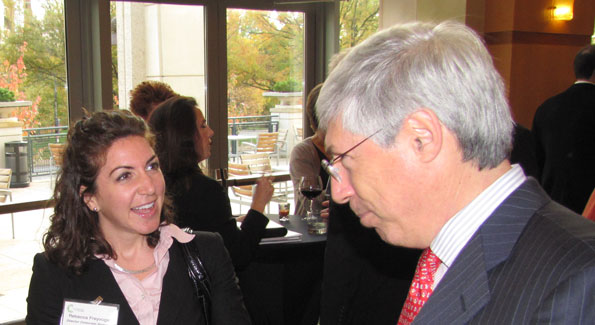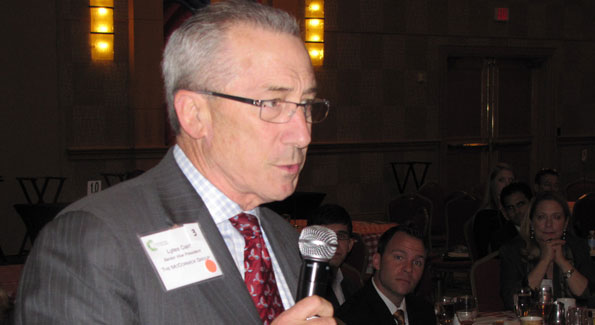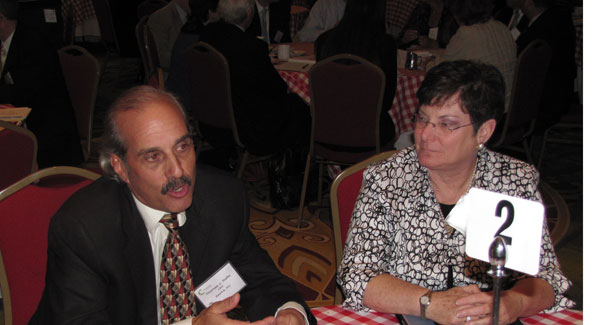Writing checks is not enough. This new organization is challenging companies to collaborate and align with nonprofits to solve social problems throughout the Washington Metro region.
By Jane Hess Collins

Rebecca Freyvogel,US Chamber of Commerce, and keynote speaker Mark Kramer. (Photo courtesy of America's Charities)
Calling all CEOs! Companies for Causes wants you to change how you do your philanthropy business. It’s time to work with like-minded businesses and nonprofits to focus time, expertise and funds to solve the region’s social issues.
Tom Raffa, CEO of RAFFA, Greater DC Care’s 2009 Business CEO of the Year for Social Value Leadership and the catalyst behind Companies for Causes, believes that a company’s corporate social responsibility extends beyond donations. Rather, Raffa believes that real social change takes the resources created of businesses and nonprofits working together.
A fierce challenge.
And nearly 200 CEOs, nonprofit executive directors, elected officials from DC, MD, and VA, and community leaders were eager to accept it at the Companies for Causes kickoff, held at the Bethesda North Marriott Hotel & Conference Center on October 27.
Called “The Power of ‘Us’: Taking Corporate Social Responsibility to the Next Level,” the event was packed with corporate, nonprofit and government panel members and speakers who shared best practices, success stories, and the success of business/ nonprofit collaboration. Examples ranging from employee-choice giving (The Brick Company) to a long term relationship (Excella and Homestretch) helped broaden the “what’s possible” discussions between business and nonprofit leaders throughout the afternoon.
There are a lot of reasons for companies to be involved. Small and mid-sized businesses will drive the economy, according to Steve Delfin, Executive Director of America’s Charities. Harry Thomas, Ward 5 Councilmember, agreed, emphasizing that businesses have the expertise and resources to help solve community issues that government and nonprofits cannot.

Lyles Carr, Senior Vice President of The McCormick Group, shares business/nonprofit collaboration ideas with the attendees. (Photo courtesy of American's Charities)
So how do a business and nonprofit find each other and determine if their interests are compatible? Like a corporate matchmaking event, CEOs met nonprofit executive directors in various venues throughout the afternoon, and then learned more about their missions during a social event after the kickoff concluded.
And finding the issue that carries personal meaning is the key to truly effective philanthropy, according to Mark Kramer, founder and managing director of FSG Social Impact. It shifts the focus from donating money to problem solving.
For long term change, business leaders need to learn about the issue they’re passionate about, engage others in the cause and see tangible results from their giving and involvement. “Money was necessary but it wasn’t the answer,” Kramer said.
Social engagement is good business too, and businesses need nonprofit engagement to succeed globally. “If we as businesses think [social responsibility] is just about being nice, giving money to charity or dividing up our profits and giving a little bit to charity, we are missing the boat,” Kramer challenged the crowd. Businesses who view the social dimension as an opportunity to be more efficient and find new markets and innovations will grow and succeed.
What can a business bring to a partnership with a nonprofit? Since nonprofits understand the complexity of the social issues, Kramer suggested business leaders help them create an infrastructure to learn from each other and align their goals, since their collective impact is more powerful.

Tom Raffa, pictured with Jeanne Sanders from Volunteer Fairfax, challenges medium-sized businesses to engage more fully with nonprofits. (Photo courtesy of America's Charities)
What issue should a business tackle? Kramer suggests picking one that matters to your business, since the CEO will know more about it and have more resources to fix it. Then commit to working on a solution. “You can’t always solve the issue,” Kramer said. “But you can certainly make progress.”
Raffa would like to see this business/nonprofit partnership model adopted in cities across the country, and he’s already getting national interest. He was pleased with the kickoff’s results, but it comes down to businesses signing on. “At the end of the day, we’ve got to get the CEOs involved,” he said. He used to promote philanthropy because it was the right thing to do, but now he sees that his company’s philanthropy-the volunteer programs, the pro bono work, the involvement with nonprofits-is what makes RAFFA successful.
Businesses thathave joined Companies for Causes got an unexpected bonus as they participated in focus groups over the summer leading to the kickoff. As the CEOs got to know each other and share their common bond of wanting to solve regional social issues through aligning with each other and nonprofits, they began to refer business to each other. So their businesses grew, along with their social commitment.
And what business wouldn’t want that?
Jane Hess Collins is a former Air Force colonel who writes to inspire people to contribute. She is also a public speaker, conducts workshops which match clients’ values with service opportunities, and has established game nights for at-risk families throughout the country. You can contact her at www.getoutandgiveback.com.
